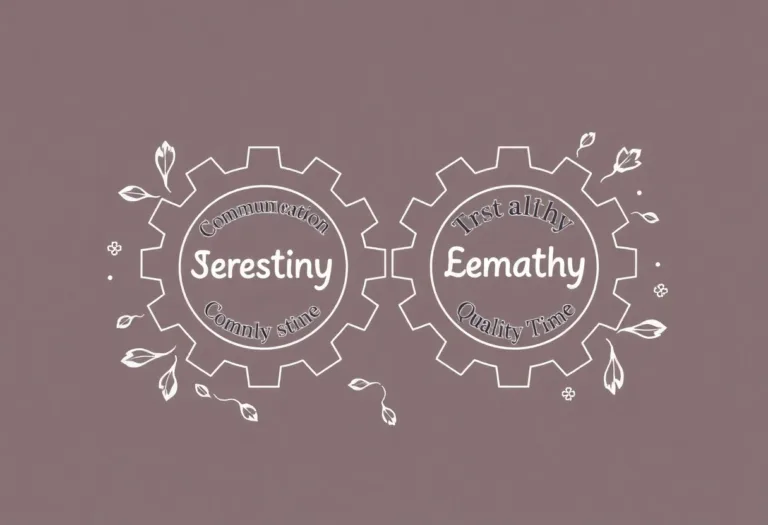8 Ways to Cultivating Emotional Intimacy: Unlocking the Secrets to a Deeper Connection
Emotional intimacy is vital in today’s world of distractions and superficial connections. Discover the importance of emotional intimacy in relationships and learn practical tips to deepen your relationship.
1. Understanding Emotional Intimacy
Emotional connection is more important than physical attractiveness and shared experiences in a relationship. While these factors may initially attract people together, it is the process of opening up and discussing one’s deepest thoughts and problems. It desires a partner that cultivates a profound and lasting emotional tie. This technique fosters trust by teaching partners to confide in and rely on one another for support.
We build an environment of understanding and empathy by revealing our deepest wants, anxieties, and vulnerabilities. Through these intimate interactions, we not only reveal our true selves but also demonstrate our desire for our partners to see and accept us. This mutual vulnerability generates a strong connection by allowing both people to feel heard, understood, and cherished. Sharing our ideas and emotions, especially when they are uncomfortable or difficult, creates the framework for an authentic connection and deepens the emotional closeness between partners.
2. Building Emotional Intimacy on Trust
Trust is the primary pillar of emotional closeness in a relationship. It provides the foundation for vulnerability, understanding, and genuine connection. To cultivate emotional closeness, creating a non-judgmental environment in which both partners may be themselves without fear of criticism or rejection is critical. This necessitates cultivating an accepting environment where each person’s opinions, feelings, and experiences are acknowledged and valued.
Building trust takes time and requires consistency and integrity. Being trustworthy is essential in developing emotional intimacy. This means keeping promises, being dependable in minor and major things, and exhibiting consistency in acts and words. We show our spouses that they can rely on us by exhibiting trustworthiness and providing a sense of security and emotional safety within the connection.
Another important part of developing trust is dependability. Being dependable and consistent in our acts and behaviours contributes to the relationship’s predictability and stability. It fosters a more profound sense of trust and emotional connection when both partners can count on each other to be there through the ups and downs.
Discretion is also essential in developing trust and emotional connection. Confidentiality and respect for our partner’s thoughts, feelings, and personal experiences reflect high trust and respect. It gives a secure area for people to open up and share their deepest ideas, knowing they will be kept private.
Emotional closeness grows in a relationship as trust grows. Both partners are comfortable being themselves, knowing they will be accepted and encouraged. Because each person feels safe revealing their vulnerabilities, dreams, and anxieties without fear of judgement or rejection, this level of trust creates great understanding and empathy.
To summarise, trust is the bedrock of emotional intimacy. We establish the framework for a relationship where emotional intimacy can develop by cultivating a non-judgmental environment and embodying integrity, dependability, and discretion. A profound emotional connection can be maintained and preserved when both parties feel safe to be themselves and trust each other’s reliability and confidentiality.
3. Emotional Intimacy: Empathy and Active Listening
Genuine listening, attention and empathy are crucial for building emotional connection in a relationship. Being fully present and attentive when conversing with our spouse is critical, as is offering them our undivided attention. This entails putting aside distractions like electronic devices and actively listening to what they are saying. By dedicating time and attention to active listening, we communicate to our partners that their thoughts and feelings are important to us and that we sincerely want to understand them deeper.
Acknowledging our partner’s emotions to establish an emotional connection through listening is critical. Validating emotions is accepting and acknowledging their sentiments without judgement. We establish a secure space for them to express themselves authentically by assuring them that their feelings are valid and understood. Emotional validation promotes trust and openness by making our partner feel noticed and understood.
Another essential part of listening with empathy is demonstrating understanding. It entails empathising with our partner’s experiences and feelings beyond simply hearing the words. By placing ourselves in their shoes, we better understand their point of view. Responding with comprehension makes our partner feel heard and valued, strengthening our emotional link.
Listening with genuine attention and empathy facilitates open and honest discussion, essential for developing an emotional connection.
Transparency and vulnerability are encouraged when our partner feels comfortable sharing their thoughts, feelings, and experiences without fear of judgement or rejection.
Intimate Home Date Ideas: Creating a Cosy and Romantic Atmosphere
As emotional closeness grows via careful listening, emotional validation, and understanding, the relationship transforms into a haven of trust, empathy, and mutual support. It establishes the foundation for efficient communication, conflict resolution, and the formation of a strong emotional attachment.
In conclusion, real attention and empathy in listening are effective approaches for cultivating emotional connection. Being totally present, carefully listening, validating emotions, and displaying understanding foster a climate conducive to open and honest dialogue. We create a deeper emotional connection with our spouse by adopting these practices into our interactions, fostering trust, understanding, and a stronger link
4. Vulnerability Sharing for Emotional Connection
Emotional intimacy can actually blossom when couples create a safe and supportive environment in which vulnerability is welcomed. We peel back the layers and show our true selves to our partners in these moments of vulnerability. It’s an invitation to share our aspirations, dreams, worries, and anxieties, exposing our deepest wants and fears. We create a space for our spouse to be honest and authentic by being honest and authentic in our expressions.
Love Languages: 6 Secrets to Meaningful Affection and Connection
The emotional bond between spouses is strengthened when we share our weaknesses and are open about our inner thoughts and emotions. We exhibit our trust in our partner’s ability to hold and support us without judgement when we dare to be vulnerable. This brave and faith-filled deed opens the door to a greater level of connection, understanding, and compassion within the partnership.
It is critical to remember that vulnerability necessitates bravery and faith. It can be difficult to expose our actual selves, especially when we are afraid of rejection or judgement. However, the advantages of vulnerability are enormous. We open the door to genuine intimacy by allowing ourselves to be vulnerable and allowing our spouse to see and accept us for who we truly are. We create a space for love, understanding, and empathy to grow by being vulnerable.
Being vulnerable enables relationship growth and evolution. We encourage our partner to join us on our self-discovery and personal development path as we share our hopes, dreams, anxieties, and uncertainties. It promotes teamwork and a shared commitment to each other’s development. Being vulnerable together strengthens our bond and lays the groundwork for a fulfilling and long-lasting partnership.
In conclusion, emotional closeness thrives when couples feel safe enough to be vulnerable with one another. We invite our partner to share our aspirations, dreams, anxieties, and doubts through the act of sharing our own. We strengthen our emotional relationship by being honest, sincere, and fearless, resulting in a profound connection based on understanding, acceptance, and support. Accepting vulnerability allows for dramatic growth and the immense rewards of deep emotional closeness.
Spending quality time together and sharing meaningful experiences is essential for nurturing and deepening relationships’ emotional connections. When couples participate in connection-promoting activities, they generate opportunities to bond, grow, and strengthen their emotional link.
Going on dates is one approach to establishing an emotional connection. Date nights allow couples to focus on one another away from the distractions of everyday life. Dates provide an opportunity to interact, talk, and enjoy each other’s company, whether it’s a romantic meal, a movie night, or a fun adventure. Couples can build a sense of closeness and strengthen their emotional connection by making time for shared experiences.
Going on walks together is another approach to strengthening emotional bonds. A quiet and intimate mood can be created by taking leisurely strolls hand in hand or exploring nature side by side. Couples can have important talks, share their thoughts, dreams, and aspirations, and openly express their feelings as they stroll and converse. Walking together represents travelling through life as a group, establishing a sense of unity and emotional intimacy.
Another effective strategy to create an emotional connection is to share shared interests. Participating in activities that both partners like deepens their bond and creates a shared feeling of purpose and fulfilment. It might be anything from sharing a passion to learning a new sport or interest as a pair or working on a joint project or goal. Couples develop their emotional connection and build a foundation of shared interests by immersing themselves in shared passions and experiences.
The formation of treasured memories is essential to spending meaningful time together. Participating in great events and adventures as a pair leaves an indelible mark on the relationship. These treasured memories form a part of the couple’s shared history, reminding them of their shared joy, love, and progress. Travelling to new locations, commemorating milestones, or going on unusual activities produce memories that serve as emotional anchors, strengthening the bond between spouses.
Finally, spending quality time together and sharing everyday experiences is critical for building relationships and emotional connections. Couples generate opportunities for meaningful interactions, open communication, and building treasured memories through going on dates, taking walks, and engaging in activities that encourage connection and shared interests. These events enrich the emotional bond and add to a sense of closeness, unity, and fulfilment.
6. The Strengthening of Emotional Bonds Through Gratitude and Compassion
Emotional ties serve as the basis for lasting connections in relationships. Gratitude and compassion stand out among the many factors that go into creating solid emotional ties. This essay explores the relationship-strengthening and emotional intimacy-fostering potential of appreciation and compassion. Learn how physical touch and appreciation for your partner’s qualities and efforts can form a strong, enduring relationship.
Developing Gratitude: Gratitude is a motivator for developing solid emotional ties within a partnership. It entails expressing gratitude for and acknowledging your partner’s good traits, deeds, and contributions. Consider your partner’s qualities that you admire and the work they put into the relationship. You may encourage your partner, help them feel valued, and strengthen your emotional bond by expressing sincere gratitude.
Expressing Appreciation: Gratitude and appreciation go hand in hand. It entails actively acknowledging and thanking your partner for all their contributions, no matter how minor. Thank them for their assistance, recognise the efforts they made, and honour their accomplishments. Consistently expressing gratitude strengthens the emotional connection and fosters a sense of shared admiration by generating a positive and validated atmosphere.
Acts of Love and Affection: Touch is a potent way to express love and concern. Hugs, kisses, and handholding are profound displays of love and connection rather than merely motions. The bonding hormone oxytocin is released during physical contact, fostering a sensation of closeness and emotional well-being. Regular displays of affection strengthen the emotional connection, remind you of your love for your partner, and increase intimacy.
Understanding and Compassion: Understanding and having compassion for your partner’s feelings, problems, and experiences entails lending assistance, kindness, and an understanding ear. Engaging in active listening is comprehending their viewpoint and acknowledging their emotions fully. You establish a secure environment for openness and vulnerability by displaying compassion and promoting emotional connection and trust.
Setting Boundaries: How to Set Healthy Limits in Your Relationship
According to research, compassion and gratitude have a good ripple impact on a relationship. Your partner is likelier to feel the same way when you show appreciation and gratitude for them. The cycle of gratitude and compassion strengthens the emotional connection and creates a positive feedback loop of admiration, love, and understanding.
Including Gratitude and Compassion in Everyday Life: Include Gratitude and Compassion in Everyday Activities To develop an awareness of the present moment and the blessings in your relationship, practise mindfulness. To dwell on the positive facets of your partner and the relationship, think about maintaining a gratitude notebook. Seek out chances to be nice and compassionate to your partner so that you can foster a nurturing and loving environment.
Compassion and gratitude are strong motivators that deepen emotional ties in relationships. You can strengthen your emotional bond with your partner by accepting acts of love and affection, expressing your appreciation, and developing a practice of thankfulness. Similarly, by engaging in acts of compassion and understanding, you establish a climate of support and acceptance that encourages emotional intimacy and trust. Accept the transforming power of appreciation and compassion, and watch as your friendship deepens into a lasting one.
7. Safe Space: Respecting Emotional Boundaries
The delicate dance of emotional connection necessitates carefully balancing respect and openness. Establishing and fostering emotional connection in a relationship requires respecting limits and boundaries. Respecting boundaries, enabling your partner to express themselves without restriction, and promoting efficient communication are discussed in this article as ways to promote a strong and sincere emotional connection. Learn how adopting open communication and appreciating the particular pace of emotional connection can improve your relationship.
Love Languages: The Secret to Meaningful Affection and Connection
The Value of Boundaries: People establish emotional fences around themselves to safeguard their personal space, emotional stability, and autonomy. It is essential to observe these boundaries to foster an atmosphere of mutual respect, safety, and trust. Emotional intimacy blossoms when both partners can express their emotions without worrying about criticism or intrusion.
Allowing your spouse to communicate freely and openly is essential for maintaining respect for limits and boundaries. Engage in active listening by paying close attention, making eye contact, and showing a sincere interest in what your partner is saying. Don’t interrupt others or impose your views. Validate their feelings and thoughts by taking note of and appreciating their viewpoint. You build a foundation of trust and respect that supports emotional closeness by actively listening and validating.
Negotiation and Communication: Each person’s emotional connection grows at their rate. It is crucial to acknowledge and celebrate this individuality. Partners can navigate and comprehend each other’s boundaries thanks to effective communication. Have frank and open discussions about your needs, wants, and limitations. Find a compromise that respects both partners’ limits and allows for the natural and genuine development of emotional connection.
Emotional Safety and Trust: Respecting boundaries makes the partnership a secure place for emotions. Partners are more inclined to open up and reveal their deepest thoughts, concerns, and aspirations when they feel comfortable and appreciated. The foundation of trust is emotional safety, which permits vulnerability and a greater connection. Respecting limits promotes a climate of trust, strengthening the emotional connection between partners.
We may learn and grow together as boundaries shift and develop over time. Maintaining awareness of your partner’s changing needs and transparency about your own is essential. Encourage one another to develop and learn as a team. An emotional bond can develop because of this shared understanding of and respect for changing boundaries.
Embracing Compassion and Patience: It takes compassion and patience to respect limits. Recognise that your partner’s boundaries reflect their individual needs rather than a rejection of you. Respect their boundaries by being tolerant and sympathetic. Allow the relationship to develop naturally and organically as the emotional connection grows at its rate.
Conclusion: Maintaining emotional intimacy in a relationship requires that both parties respect each other’s limitations and boundaries. You may foster trust, safety, and respect by allowing your partner to express themselves freely, respecting the special place of emotional connection, and embracing efficient communication. Respecting limits promotes openness, development, and a stronger emotional connection. Remember that developing emotional connections is a journey that calls for perseverance and comprehension. Setting limits in your relationship opens the door for a satisfying and sincere emotional connection.
8. Communication Leads to Intimacy
Strengthening Emotional Intimacy Through Meaningful Dialogues: The Power of Deep Conversation: Deep and meaningful talks have the potential to forge a profound link between couples in the area of emotional intimacy. Couples can better comprehend one another’s inner lives by having in-depth conversations about their shared values, beliefs, aspirations, dreams, anxieties, and problems. In this essay, we explore the relationship-deepening potential of meaningful dialogue and how it encourages emotional closeness. Learn the value of honesty, expressing feelings and views, and having thoughtful conversations to foster a solid and sincere emotional relationship.
Unveiling Your Inner World: Engaging in a deep conversation with a partner invites you to go into the depths of your inner world. It requires discussing your underlying principles, the ideas that inform your worldview, and the objectives that motivate your aspirations. Being honest with your spouse about these core elements of who you are gives them a chance to connect with and fully understand you.
Hopes, anxieties, and challenges: When couples are willing to discuss their hopes, anxieties, and challenges, emotional intimacy flourishes. When discussing your goals and aspirations, your spouse can help motivate you to reach them. Sharing your anxieties fosters empathy and understanding, which gives the partnership a sense of security. Discussing your challenges with one another creates a space for collaborative problem-solving, which promotes resilience and teamwork.
Making a Safe and Nonjudgmental Space: A safe and nonjudgmental setting is necessary for deep dialogue. Both partners should try to foster an environment where vulnerability is met with acceptance and empathy. Give your companion your attention while listening to their thoughts and feelings actively. Reassure and affirm their feelings, letting them know you cherish and respect them. Genuine and open conversation is made possible in this secure environment, fostering emotional closeness.
Exploring Emotions and Thoughts: It is crucial to explore and openly talk about your emotions and thoughts to increase emotional intimacy. Share the successes, setbacks, and difficulties that help define your emotional landscape. When you are vulnerable, your partner can empathise with you and provide your support. You create a solid basis for emotional connection by examining and validating each other’s feelings and thoughts.
Empathy and understanding development: Having a deep conversation with someone allows you to foster empathy and understanding in your connection. Actively hear your partner’s experiences as you share your inner world. Try to comprehend their feelings, ideas, and viewpoints. You develop a strong sense of connection and support by sharing each other’s journeys, eventually increasing emotional closeness.
Fostering Mutual Understanding and Personal Progress: Deep dialogues about values, beliefs, aspirations, hopes, fears, and barriers promote interpersonal understanding and personal progress. It creates a setting where both parties can grow personally and in their relationships. Remember to acknowledge each other’s development as you engage in these deep conversations and cherish the connections they establish.
To foster emotional connection in a relationship, deep communication is a strong technique. Couples can develop a closer understanding of one another by talking about their shared values, beliefs, ambitions, dreams, anxieties, and problems.
The creation of a safe and judgment-free environment, the exploration of emotions and thoughts, and the growth of empathy and understanding all contribute to the development of emotional intimacy. A deeper sense of connection and mutual support will become stronger in your relationship as you embrace the transforming potential of meaningful discussion.
Nurturing emotional closeness is a never-ending process requiring effort, patience, and openness. You may establish a deep and meaningful relationship with your spouse by building trust, practising active listening, sharing vulnerability, fostering emotional intelligence, spending quality time, expressing appreciation, and respecting boundaries.
Conclusions
Emotional closeness takes time, patience, and transparency. You may build a deep and lasting relationship with your spouse by trusting, listening, sharing vulnerability, creating emotional intelligence, spending quality time, expressing gratitude, and respecting boundaries.
Developing an emotional connection is the key to a happier relationship. It takes time and effort, but the rewards are huge.
Emotional intimacy strengthens connection, understanding, and support in a partnership.
An emotional connection is shared. Both partners must work to create a safe space for vulnerability and open communication. Celebrate each other’s growth as reciprocal effort and dedication deepen the emotional connection.

Remember that emotional connection is a process. As you face life’s challenges together, prioritise emotional connection. Embrace vulnerability, cherish shared experiences, and seek greater understanding and support.
We will discuss other ways to build emotional connections and a lasting relationship in future blog postings. Relationship insights will continue.
Allow emotional connection to transform your relationship. Grow closer and share vulnerability, understanding, and love.
With best wishes
Harmonious Resolutions: 8 Best Strategies for Conflict Resolution in Relationships








